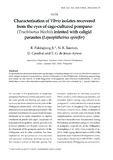Sea lice, Lepeophtheirus salmonis and Caligus orientalis (Copepoda: Caligidae), of wild and farmed fish in sea and brackish waters of Japan and adjacent regions: A review
- Global styles
- MLA
- Vancouver
- Elsevier - Harvard
- APA
- Help

URL ที่เชื่อมโยง
zoolstud.sinica.edu.twวันที่
2004ผู้เขียน
Page views
1,031ASFA keyword
AGROVOC keyword
Taxonomic term
เมตาดาต้า
แสดงระเบียนรายการเต็ม
Share
นามธรรม
This paper reviews various aspects of the biology and effects of 2 caligid copepods, Lepeophtheirus salmonis and Caligus orientalis, on wild and farmed fish in sea and brackish waters of Japan and adjacent regions. Lepeophtheirus salmonis is a common parasite of wild adult chum (Oncorhynchus keta) and pink (O. gorbuscha) salmon migrating in northern Japanese waters. Masu salmon (O. masou) have the lowest level of infection. Juvenile chum salmon are sometimes infected. This parasite is also found on salmonids in Korean and Russian waters. The species occurs on coho salmon (O. kisutch) and rainbow trout (O. mykiss) farmed in coastal waters of northern Japan, but its infection is not a serious problem, because only young fish are reared and harvested in less than a year of culture and thus no fish are cultured during summer. This situation is very different from that in Scotland, Ireland, Norway, and Canada where L. salmonis causes serious damage to farms of Atlantic salmon (Salmo salar). Caligus orientalis is a parasite of coastal marine and brackish-water fish in Japan and neighboring countries (Taiwan, China, Korea, and Russia). This parasite has a wide host range and has been reported from over 20 fish species from different orders and families. It infects farmed and experimentally reared fish, such as rainbow trout in Japan, grey mullet (Mugil cephalus) and black porgy (Acanthopagrus schlegeli) in Taiwan, and Mozambique tilapia (Oreochromis mossambicus) in China. Heavy infection results in appetite reduction and death of fish. The parasite is one of the most important pathogens at brackish-water fish farms in Far East Asia.
การอ้างอิง
Nagasawa, K. (2004). Sea lice, Lepeophtheirus salmonis and Caligus orientalis (Copepoda: Caligidae), of wild and farmed fish in sea and brackish waters of Japan and adjacent regions: A review. Zoological Studies , 43(2), 173-178. http://hdl.handle.net/10862/2020
Type
ArticleISSN
1021-5506คอลเลกชัน
- Journal Articles [1258]
Related items
Showing items related by title, author, creator and subject.
-
Seasonal population dynamics of Lepeophtheirus spinifer and Neobenedenia sp. coinfecting snubnose pompano (Trachinotus blochii) breeders in marine cages in the Philippines
Palma, Peter ; Beluso, Lyra Angelica; de Jesus-Ayson, Evelyn Grace; Cruz-Lacierda, Erlinda R. (Elsevier, 2022)
Studies on the biology and ecology of sea lice are lacking in tropical regions such as in Southeast Asia where finfish cage farming has grown dramatically in the past decades. This study investigated the seasonal population ...
; Beluso, Lyra Angelica; de Jesus-Ayson, Evelyn Grace; Cruz-Lacierda, Erlinda R. (Elsevier, 2022)
Studies on the biology and ecology of sea lice are lacking in tropical regions such as in Southeast Asia where finfish cage farming has grown dramatically in the past decades. This study investigated the seasonal population ... -
Characterisation of Vibrio isolates recovered from the eyes of cage-cultured pompano (Trachinotus blochii) infested with caligid parasites (Lepeophtheirus spinifer)
Pakingking, Rolando V., Jr. ; Bautista, Norwell B.; Catedral, Demy; de Jesus-Ayson, Evelyn Grace (European Association of Fish Pathologists, 2018)
Exophthalmia was documented among sea cage-cultured pompano (Trachinotus blochii) broodstocks with caligid parasite (Lepeophtheirus spinifer) infestation in the Philippines. Following sequencing, and based on the results ...
; Bautista, Norwell B.; Catedral, Demy; de Jesus-Ayson, Evelyn Grace (European Association of Fish Pathologists, 2018)
Exophthalmia was documented among sea cage-cultured pompano (Trachinotus blochii) broodstocks with caligid parasite (Lepeophtheirus spinifer) infestation in the Philippines. Following sequencing, and based on the results ... -
Series: Aquaculture extension manual; No. 76
Manual on important marine parasites and their hosts in the Philippines
Erazo-Pagador, Gregoria; Caloyloy, Blan Jericho; de la Peña, Leobert D. (Aquaculture Department, Southeast Asian Fisheries Development Center, 2024-07)This manual gives basic information on some parasites of different infected fish submitted to the Southeast Asian Fisheries Development Center/ Aquaculture Department (SEAFDEC/AQD) Diagnostic Service Laboratory in Tigbauan, ...





